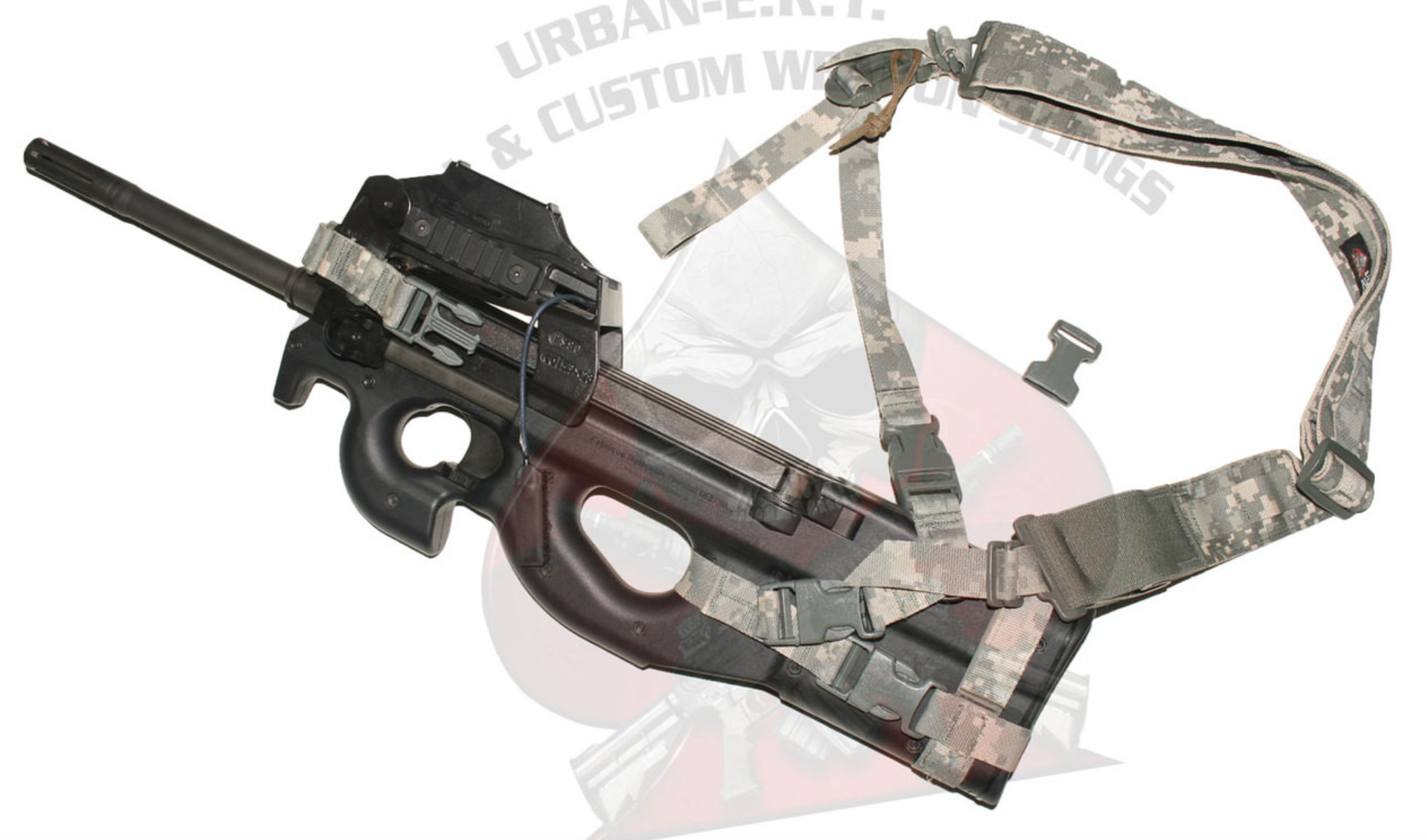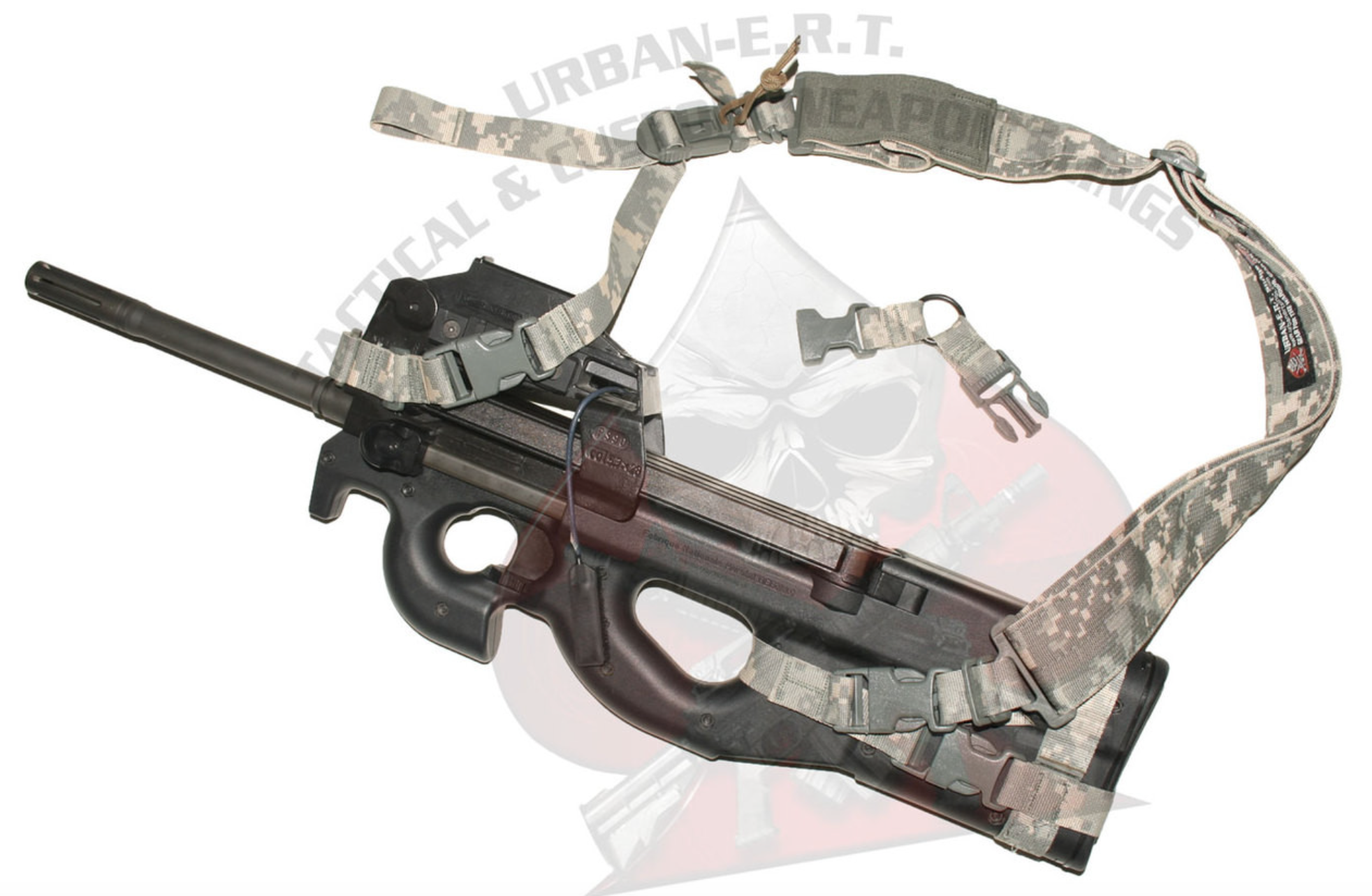Posted by Sgt. Matt Murray on Nov 11 2024
Choosing the Right P90 Sling, Single-Point vs. Two-Point Explained by an Expert.
Choosing the Right P90 Sling
Single-Point vs. Two-Point Explained by an Expert
When it comes to tactical gear, there’s nothing more personal than your choice of sling. It’s not just an accessory; it’s a tool that can make or break your ability to operate effectively. As the owner of URBAN-ERT SLINGS, I’ve spent years designing and manufacturing custom slings for all kinds of users, from civilian shooting enthusiasts to military and law enforcement professionals. And as a 26-year police veteran with 17 years on SWAT—including 3 years as a sniper—I’ve had my fair share of experience testing slings in the field. Let’s talk about the pros and cons of single-point and two-point slings, particularly for the P90, and how to decide which one is right for you.
What Are Single-Point and Two-Point Slings?
Single-Point Slings

A single-point sling attaches to your weapon at a single mounting point, typically near the rear of the receiver. In the case of our P90 adapter, specifically to a rear P90 harness that relocates the connection point from the back bottom of the stock to the side just rear of the thumbhole of the stock. This design is simple, fast, and highly effective for quick transitions and close-quarters combat (CQC). A single-point sling allows your weapon to hang naturally in front of you, keeping it accessible at all times. Our P90 Rear Harness raises the profile of the weapon and positions the weapon vertically muzzle down.
Two-Point Slings

In contrast, a two-point sling attaches at two separate points on your firearm, usually at the front and rear. This setup provides more stability, adjustability, and versatility. You can carry your weapon in multiple configurations, such as across your chest or slung over your back, making it ideal for long-range patrols or extended operations. While configured as a two point, our P90 front and rear harnesses allow for the weapon to hang across the torso with the weapon positioned appropriately for rapid deployment unlike using the factory sling connection which makes the P90 hang upside down.
Advantages and Drawbacks of Single-Point Slings
The Pros
Single-point slings shine in dynamic environments. They’re great for:
- Quick Transitions: If you need to switch from your P90 to your sidearm in a split second, a single-point sling won’t get in your way.
- Close-Quarters Combat: When you’re clearing rooms or moving through tight spaces, the simplicity of a single-point sling is hard to beat.
- Ease of Use: There’s no fumbling with adjustments or extra straps. You just clip it on and go.
- Ability to secure the front: With the addition of the optional weapons catch adapter, you can secure the front of the weapon to your offhand side connecting the weapons catch to the front harness adapter.
I remember a time during a SWAT operation when I needed to transition from my primary weapon to a breaching shotgun and back again in seconds. My single-point sling made it possible to do this seamlessly without losing control of my weapon, I simply let go of the rifle, brought the shotgun around to the front, deployed it, stowed it back behind me, and went hands on with the rifle again.
The Cons
However, single-point slings have their downsides:
- Stability Issues: The weapon can swing freely, which becomes a problem when running or climbing.
- Lack of Support: When attempting to take a suspect into custody, without a weapons catch, the rifle has no front support to secure it.
Advantages and Drawbacks of Two-Point Slings
The Pros
Two-point slings are versatile and provide excellent support. Key benefits include:
- Stability and Comfort: By distributing the weight of your weapon across two points, a two-point sling offers greater stability and comfort for extended wear and easier hands free abilities.
- Multiple Carry Options: You can adjust the sling to carry your P90 in various ways, from a ready position to slung on your back.
- Enhanced Control: The two-point setup keeps your weapon tight to your body, reducing swing and making it easier to maneuver in confined spaces.
When I worked as a sniper, I often relied on a two-point sling for the added stability it provided for my primary weapon. Whether I was scaling fences or crawling into a concealed position, the two-point configuration kept my rifle secure and ready for action.
The Cons
While two-point slings are excellent for certain scenarios, they’re not perfect:
- Slower Transitions: Switching from your P90 to another weapon or tool can take a bit longer.
- Complex Adjustments: It takes time to learn how to make quick adjustments for different carry positions.
Choosing the Right Sling for Your Needs
So, which sling method of carry is right for you? It depends on your role, mission, and personal preferences. Here’s a breakdown:
For Law Enforcement Professionals
If you’re on a tactical team or SWAT, a single-point sling might be your best bet for high-speed, high-pressure scenarios. On the other hand, patrol officers who need to carry their weapon for long shifts may find a two-point sling more comfortable.
For Military Operators
For soldiers, versatility is key. Two-point slings are ideal for long-range patrols and diverse terrain, offering the stability you need when traversing challenging environments. However, single-point slings can be useful for specific roles, like vehicle operators or breachers.
For Civilian Shooting Enthusiasts
Recreational shooters and hunters should consider their typical use case. If you’re spending a day at the range, a single-point sling offers simplicity and ease of use. If you’re hunting or participating in tactical competitions, a two-point sling’s adjustability and support will serve you better.
The Best of Both Worlds: The P90 Hybrid Sling
What if you could combine the benefits of both single-point and two-point slings? That’s exactly what our URBAN-SENTRY Hybrid Sling offers. Designed specifically for the P90, this sling transitions seamlessly between single-point and two-point configurations and for left hand or right hand shooters. Need quick access for a dynamic entry? Use the single-point mode. Want stability for a long patrol? Switch to the two-point setup in under a minute.
As someone who has spent years designing and field-testing slings, I can confidently say that this hybrid solution is a game-changer. It’s built with high-quality, American-made materials and designed to perform in the toughest conditions.
Key Considerations Before Buying a Sling
Here are some factors to keep in mind when choosing your P90 sling:
- Compatibility: Make sure the sling is designed to work with your P90’s unique shape and attachment points.
- Durability: Look for slings made with mil-spec webbing and high-quality hardware.
- Adjustability: A good sling should be easy to adjust for different body types and gear setups.
- Training: Practice with your sling to ensure you can use it effectively under stress.
Conclusion
Choosing the right sling for your P90 is a personal decision that depends on your role, environment, and preferences. Single-point slings offer speed and simplicity, while two-point slings provide stability and versatility. If you’re torn between the two, consider a hybrid sling like the URBAN-SENTRY for the best of both worlds, because in the end, with our P90 hybrid sling, you can have your cake and eat it too.
Ready to find your perfect sling? Visit URBAN-ERT SLINGS to explore our selection of premium P90 slings, trusted by law enforcement, military personnel, and shooting enthusiasts worldwide.

